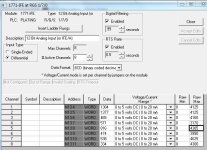hardaysknight
Lifetime Supporting Member
I've got a 4-20ma pressure transducer connected to an analog card on an AB PLC5. Under the setup for the card, I have to set a raw minimum and maximum input range. I'm confused about how to set this up.
The pressure transducer is an IFM PT5460. In the manual for it, it says that the input range is 0-600 bar, with a 1500 Pmax.
Should I set the min/max range to 0-600, or 0-1500 in the PLC5?
The pressure transducer is an IFM PT5460. In the manual for it, it says that the input range is 0-600 bar, with a 1500 Pmax.
Should I set the min/max range to 0-600, or 0-1500 in the PLC5?





